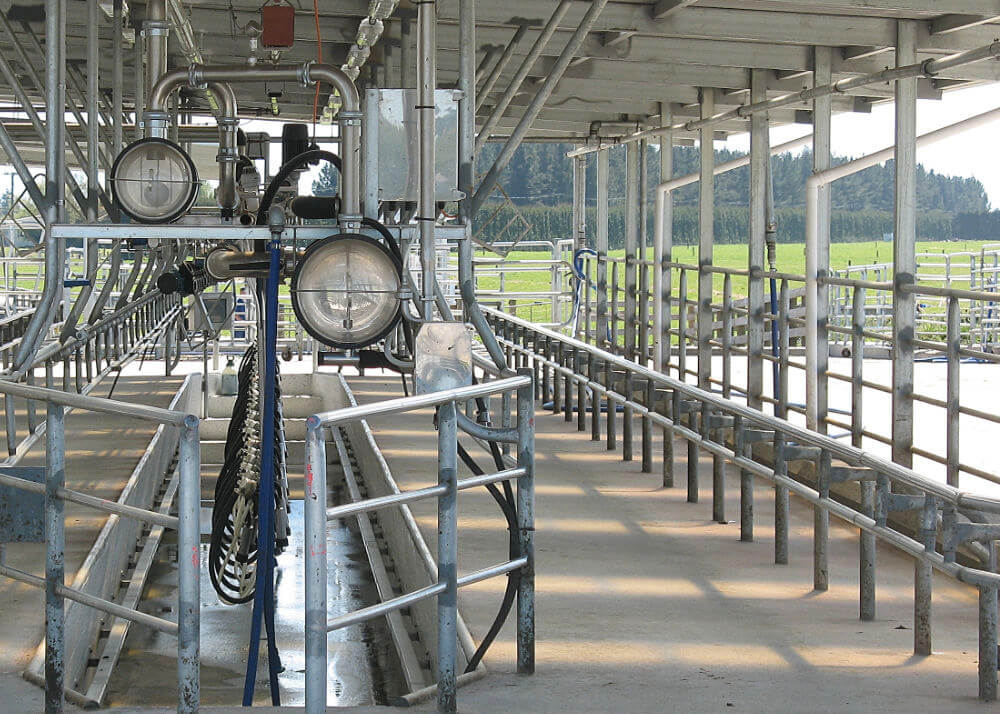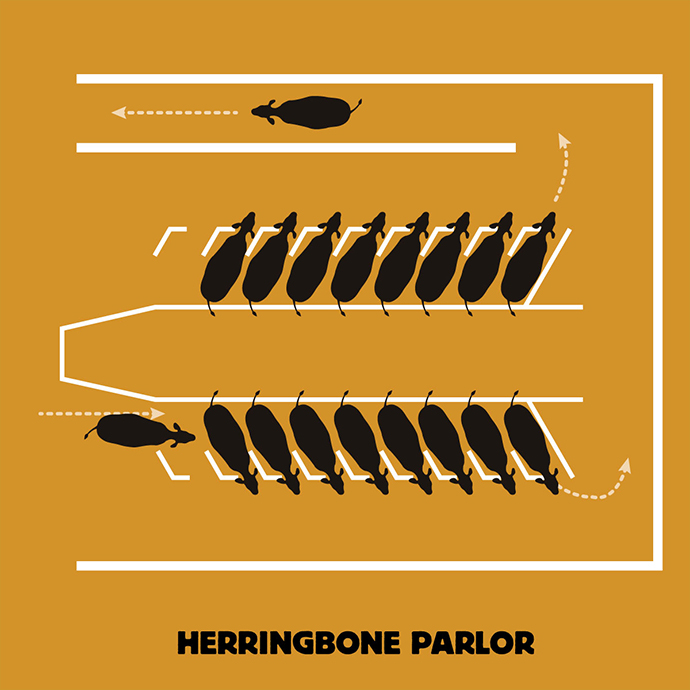Walking distance between cows is 69-76 cm 27-30 in. Purchased herringbone parallel or simple custom-built stalls are used for the cow platform.

Using A Herringbone Dairy Shed Farm Buildings Te Ara Encyclopedia Of New Zealand
More detailed information on vat design and construction can be found in Grandin 1980ac 1983a.

. Herringbones are kind of shaped like a fish skeleton and cows line up on either side where the bones would branch out from the spine. The cows face outward. Small modification to design can significantly improve cow flow without costing too much.
In short evaluate design critically for factors impeding good cow flow. The farmer puts the milking cups on the cow teats from. Herringbone sheds In herringbones HB the number of cows milked per hour is determined by the operator.
Herringbone parlors are the most common design used on dairy farms with smaller herds. Benefits of getting it right include decreased animal health costs increased worker safety and comfort and decreased injuries. The cattle stand at a 45-degree angle.
The farmer stands in a sunken pit in the middle - just like the type of pit a mechanic works from. In Sharps system the cows line up on either side of a central pit where the operator can put on and take off the milking cups without having to bend down. One of the most common milk sheds the herringbone shed has a central sunken pit and a raised platform on each side where the cows stand whilst being milked.
The cows are angled anywhere from 45 to 90 degrees to the pit and the pit which is usually two to three metres wide is where the milking staff work. Barfootes design is simple and economically suited to a farm that milks 100 - 400 cows. In Sharps system the cows line up on either side of a central pit where the operator can put on and take off the milking cups without having to bend down.
Herringbone Design Making sure cows are comfortable while entering and exiting the dairy as well as during milking will have big benefits for cow flow and efficiency. So it almost becomes secondary whether you choose milking from a GEA herringbone milking parlor a parallel milking parlor side-by-side or a tandem milking parlor. This design offers the milker a different access point to the udder than the parallel or tandem designs and also allows access for different types of equipment to be used.
HERRINGBONE ROTARY DAIRY SHEDS MADE FOR THE WEST COAST. New Zealand Goat Farmers Wiebe and Piety Smitstra retrofitted their goat milking shed with a GEA low line double-up herringbone system including automatic cup removers milk meters and DairyPlan software. We work to configure the best cow comfort cow flow operator comfort shed layout and pathways from.
Don Chapman Waikato is a licensee for Chapman Dairy Ltd who have been designing and building milking parlours since 1967. We specialise in herringbone dairy sheds and rotary dairy sheds for Hokitika and West Coast based dairy farmers. Herringbone Bail and Pit Design - DairyNZ.
Animal-friendly stall design optimal cow positioning and a fast as well as gentle milking process have a positive effect on udder health. When good cow flow is achieved then efficient milking practices can be implemented. Systems by actually milking in each design rather than simply observing the parlour.
Many vat builders make the mistake of building a slide. A slide is a bad design because the cattle sometimes flip over backwards while going down the slide. Cow centered design Operator and cow comfort are of paramount importance and all Dairymaster parlour designs reflect this requirement.
In 1952 Ron Sharp a Waikato dairy farmer developed the herringbone shed design which transformed the milking process. Swing - Swing parlour designs are used to minimize parlour investment. GEA milking system upgrade shaves 2 hours off daily milking.
Barfootes herringbone can easily be tailored to suit your own requirements. Barfoote Herringbone Milking Sheds are cost effective. The herringbone shed was developed by Ron Sharp a farmer from the Waikato in 1952.
Over 40 years of continuous improvement of our designs through innovation client feedback and new compliance requirements ensure you the client are getting the best value for your money. The milking unit is used on two stalls and is swung from one side of the parlour pit to the other. Dairy Parlour Design and Construction.
There are a range of widths and other critical dimensions for the herringbone the 2 6 and the side-by-side parlours and these are shown below. In herringbone milking sheds or parlours cows enter in single file and line up almost perpendicular to the central aisle of the milking parlour on both sides of a central pit in which the milker works you can visualise a fishbone with the ribs representing the cows and the spine being the milkers working area. We offer our customers a turn-key.
The animal will seldom attempt to back out because it does not start slipping. These are guidelines only so consult milking machine manufacturers to get the exact dimensions for their machines. One of the most common milk sheds the herringbone shed has a central sunken pit and a raised platform on each side where the cows stand whilst being milked.
The design of the milking bail pipework and pit is an important factor in keeping cows and people safe and ensuring good cow flow. Westland Dairy Sheds has been assisting farmers in Hokitika and on the West Coast with new herringbone and rotary dairy shed builds for over a decade. Let GEA support you.

Herringbone Milking Systems Read Industrial Ltd

4 Modern Milking Parlor Designs Dairy Discovery Zone

Buildings Focus 16 Unit Parlour And Drafting System All Under The One Roof In Co Westmeath Agriland Ie

Herringbone Bail And Pit Design Dairynz

Herringbone Bail And Pit Design Dairynz


0 comments
Post a Comment